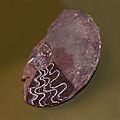
Ammonoids are a group of extinct marine mollusc animals in the subclass Ammonoidea of the class Cephalopoda. These molluscs, commonly referred to as ammonites, are more closely related to living coleoids than they are to shelled nautiloids such as the living Nautilus species. The earliest ammonites appeared during the Devonian, with the last species vanishing during or soon after the Cretaceous–Paleogene extinction event.

Orthoceras is a genus of extinct nautiloid cephalopod restricted to Middle Ordovician-aged marine limestones of the Baltic States and Sweden. This genus is sometimes called Orthoceratites. Note it is sometimes misspelled as Orthocera, Orthocerus or Orthoceros.

Orthocerida is an order of extinct Orthoceratoid cephalopods also known as the Michelinocerida that lived from the Early Ordovician possibly to the Late Triassic. A fossil found in the Caucasus suggests they may even have survived until the Early Cretaceous. They were most common however from the Ordovician to the Devonian.
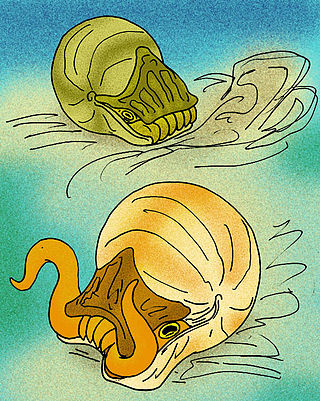
Arcestes is a genus of extinct ceratitid ammonites found in Triassic-aged marine strata.
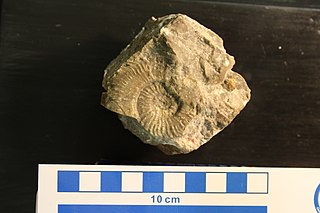
Arpadites is a genus of ceratitids in the family Trachyceratidae from the Middle and Upper Triassic of Nevada, Alps, Italy, Balkans, Himalayas, and Japan.

Medlicottiidae is a family of ammonoid cephalopods belonging to the Prolecanitida, known from the Upper Carboniferous (Pennsylvanian) to the Early Triassic.

Prolecanitida is an order of extinct ammonoid cephalopods, the major Late Paleozoic group of ammonoids alongside the order Goniatitida. Prolecanitids had narrow shells, discoidal (disc-shaped) to thinly lenticular (lens-shaped). They retained a retrochoanitic siphuncle, a simple form with septal necks extending backwards. As is typical for ammonoids, the siphuncle sits along the ventral margin of the shell.

The Trachyceratidae is an extinct family of ceratitid ammonoid cephalopods.
The Danubitoidea is a large and diverse superfamily in the order Ceratitida of the Ammonoidea that combines five families removed from the Ceratitaceae, Clydonitaceae, and Ptychitaceae.
Longobarditidae is a family of ceratitd ammonoids known from the early Triassic, included in the Danubitaceae. Longobarditidae includes genera formerly placed in Hungaritidae by the American Treatise on Invertebrate Paleontology, Part L, 1957 as well as genera that have been described since.

Gymnites is a genus of ammonoid cephalopod from the Middle Triassic belonging to the ceratitid family Gymnitidae. These nektonic carnivores lived during the Triassic period, Anisian age.

Arcestidae is an extinct family of ammonite cephalopods.
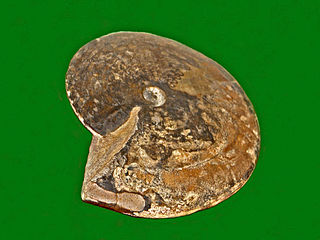
Hedenstroemia is an extinct genus of Early Triassic (Olenekian) cephalopods in the ammonoid order Ceratitida. They were nektonic carnivores.

Hedenstroemiidae is an extinct family of cephalopods in the ammonoid order Ceratitida. They were nektonic carnivores.
The Candelaria Formation is a geologic formation in Nevada, United States. The formation comprises shales and limestones deposited in an open marine environment and preserves fossils dating back to the Induan age of the Early Triassic epoch. Outcrops of the Candelaria Formation are present in the Candelaria Hills southeast of the now abandoned minig town of Candelaria, and near Willow Springs.

Ophiceras is a genus of smooth, evolute ceratitid ammonites from the Early Triassic, with a rounded venter. Fossils of the genus have been found in Armenia, Azerbaijan, China, Greenland, and India.
Sturia is a genus of ceratitid ammonoids from the Lower Triassic with an ammonitic suture.
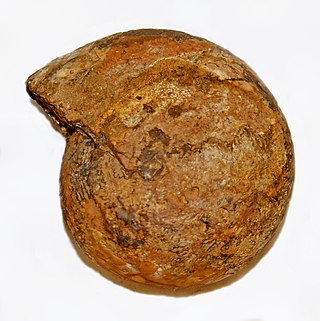
Halorites is an extinct genus of Triassic ammonoids belonging to the family Haloritidae.
The Xiaowa Formation is a Carnian-age geological formation found in southern China. It is a sequence of limestone and marls from the Carnian stage of the Triassic. Its lower section was previously known as the Wayao Formation or Wayao Member of the Falang Formation. In 2002, the Wayao Member was renamed and raised to the Xiaowa Formation to prevent confusion with an Eocene unit of the same name. Crinoids and marine reptiles are abundant in the Xiaowa Formation, forming a lagerstätte known as the Guanling biota. Ammonoids and conodonts found in the formation constrain its age to the early Carnian. Reptiles of the Guanling biota include ichthyosaurs, thalattosaurs, placodonts, and Odontochelys. Sedimentary events within this formation have been tied to the Carnian Pluvial Event.
Liostrea is a genus of extinct oysters, marine bivalve mollusks in the family Gryphaeidae.

